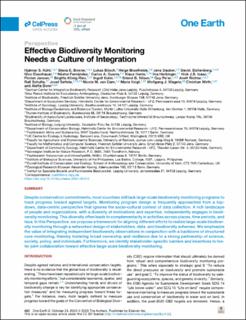Effective biodiversity monitoring needs a culture of integration
Kühl, H.S.; Bowler, Diana Elizabeth; Bösch, L.; Bruelheide, H.; Dauber, J.; Eichenberg, D.; Eisehower, N.; Fernandez, N.; Guerra, Carlos A.; Henle, Klaus; Herbinger, Ilka; Isaac, Nick J.B.; Jansen, Florian; König-Ries, Birgitta; Kühn, Ingolf; Nilsen, Erlend Birkeland; Pe'er, Guy; Richter, Anett; Schulte, Ralf; Settele, Josef; van Dam, Nicole M.; Voigt, Maria; Wägele, Wolfgang J.; Wirth, Christian; Bonn, Aletta
Peer reviewed, Journal article
Published version

Åpne
Permanent lenke
https://hdl.handle.net/11250/2685603Utgivelsesdato
2020Metadata
Vis full innførselSamlinger
- Publikasjoner fra CRIStin - NINA [2364]
- Scientific publications [1392]
Sammendrag
Despite conservation commitments, most countries still lack large-scale biodiversity monitoring programs to track progress toward agreed targets. Monitoring program design is frequently approached from a topdown, data-centric perspective that ignores the socio-cultural context of data collection. A rich landscape of people and organizations, with a diversity of motivations and expertise, independently engages in biodiversity monitoring. This diversity often leads to complementarity in activities across places, time periods, and taxa. In this Perspective, we propose a framework for aligning different efforts to realize large-scale biodiversity monitoring through a networked design of stakeholders, data, and biodiversity schemes.We emphasize the value of integrating independent biodiversity observations in conjunction with a backbone of structured core monitoring, thereby fostering broad ownership and resilience due to a strong partnership of science, society, policy, and individuals. Furthermore, we identify stakeholder-specific barriers and incentives to foster joint collaboration toward effective large-scale biodiversity monitoring.
